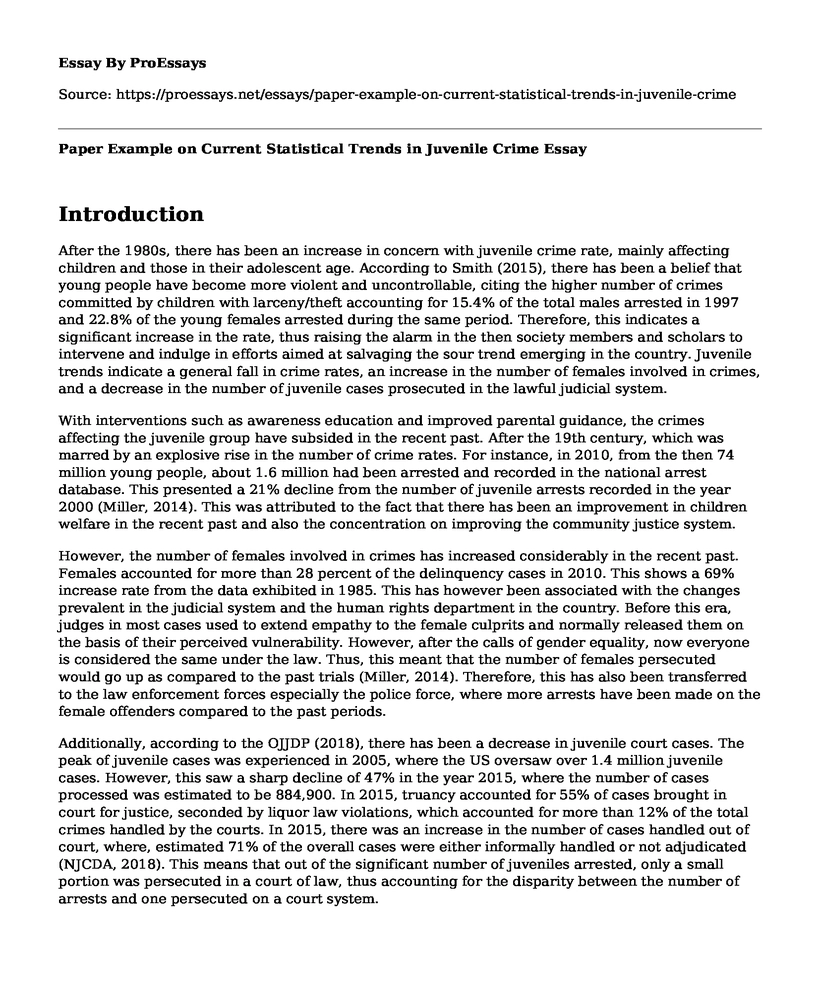Introduction
After the 1980s, there has been an increase in concern with juvenile crime rate, mainly affecting children and those in their adolescent age. According to Smith (2015), there has been a belief that young people have become more violent and uncontrollable, citing the higher number of crimes committed by children with larceny/theft accounting for 15.4% of the total males arrested in 1997 and 22.8% of the young females arrested during the same period. Therefore, this indicates a significant increase in the rate, thus raising the alarm in the then society members and scholars to intervene and indulge in efforts aimed at salvaging the sour trend emerging in the country. Juvenile trends indicate a general fall in crime rates, an increase in the number of females involved in crimes, and a decrease in the number of juvenile cases prosecuted in the lawful judicial system.
With interventions such as awareness education and improved parental guidance, the crimes affecting the juvenile group have subsided in the recent past. After the 19th century, which was marred by an explosive rise in the number of crime rates. For instance, in 2010, from the then 74 million young people, about 1.6 million had been arrested and recorded in the national arrest database. This presented a 21% decline from the number of juvenile arrests recorded in the year 2000 (Miller, 2014). This was attributed to the fact that there has been an improvement in children welfare in the recent past and also the concentration on improving the community justice system.
However, the number of females involved in crimes has increased considerably in the recent past. Females accounted for more than 28 percent of the delinquency cases in 2010. This shows a 69% increase rate from the data exhibited in 1985. This has however been associated with the changes prevalent in the judicial system and the human rights department in the country. Before this era, judges in most cases used to extend empathy to the female culprits and normally released them on the basis of their perceived vulnerability. However, after the calls of gender equality, now everyone is considered the same under the law. Thus, this meant that the number of females persecuted would go up as compared to the past trials (Miller, 2014). Therefore, this has also been transferred to the law enforcement forces especially the police force, where more arrests have been made on the female offenders compared to the past periods.
Additionally, according to the OJJDP (2018), there has been a decrease in juvenile court cases. The peak of juvenile cases was experienced in 2005, where the US oversaw over 1.4 million juvenile cases. However, this saw a sharp decline of 47% in the year 2015, where the number of cases processed was estimated to be 884,900. In 2015, truancy accounted for 55% of cases brought in court for justice, seconded by liquor law violations, which accounted for more than 12% of the total crimes handled by the courts. In 2015, there was an increase in the number of cases handled out of court, where, estimated 71% of the overall cases were either informally handled or not adjudicated (NJCDA, 2018). This means that out of the significant number of juveniles arrested, only a small portion was persecuted in a court of law, thus accounting for the disparity between the number of arrests and one persecuted on a court system.
Conclusion
In conclusion, the Juvenile trends have indicated a general fall in crime rates, an increase in the number of females involved in crimes, and a decrease in the number of juvenile cases prosecuted in the lawful judicial system. This has been attributed to a 21% decline from the number of juvenile arrests recorded in the year 2000, females accounting for 28 percent of the delinquency cases in 2010, and 71% of the overall cases either informally handled or not adjudicated.
References
Miller, L. (2014). Juvenile crime and juvenile justice: Patterns, models, and implications for clinical and legal practice. Aggression and Violent Behavior, 19(2), 122-137. doi: 10.1016/j.avb.2014.01.005.
NJCDA. (2018). National Juvenile Court Data Archive. Retrieved from https://www.ojjdp.gov/ojstatbb/njcda/.
OJJDP. (2018). Estimated number of juvenile arrests, 2016. Retrieved from https://www.ojjdp.gov/ojstatbb/crime/qa05101.asp.
Smith, M. (2015). NCJJ Report Shows Juvenile Crime Keeps Falling, But Reasons Elusive. Retrieved from https://jjie.org/2015/02/26/ncjj-report-shows-juvenile-crime-keeps-falling-but-reasons-elusive/.
Cite this page
Paper Example on Current Statistical Trends in Juvenile Crime. (2022, Jun 19). Retrieved from https://proessays.net/essays/paper-example-on-current-statistical-trends-in-juvenile-crime
If you are the original author of this essay and no longer wish to have it published on the ProEssays website, please click below to request its removal:
- William Rodriguez Case Study
- Essay Example on Tech Crime: Balancing Justice and Security With New Technologies
- Marijuana Legalization: Should We Take the Leap? - Essay Sample
- 1964 Civil Rights Act: Heart of Atlanta Motel v. US - A Legal Challenge - Research Paper
- Annotated Bibloography Example: Comparative Analysis of Juvenile Justice and Mood Disorders
- Free Paper Sample on Unmasking Human Trafficking: A Closer Look
- Cybercrime Investigative Techniques - Report Sample







